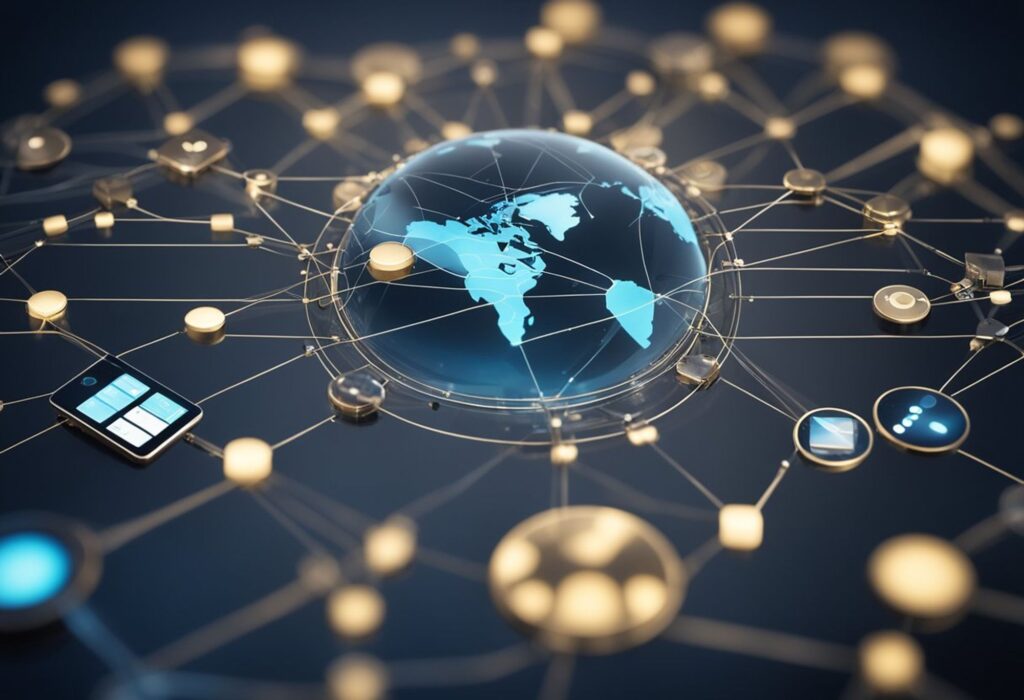How to Reach Customers Everywhere
B2B omnichannel marketing is a strategy that involves leveraging multiple channels to reach customers at various stages of the buying journey. It involves creating a seamless and cohesive experience for the customer across all channels, including online and offline interactions. The ultimate goal of B2B omnichannel marketing is to provide customers with a consistent and personalized experience that meets their needs and preferences.

In today’s digital age, B2B buyers are more informed and empowered than ever before. They expect a seamless and personalized experience across all channels, and they want to interact with companies on their own terms. B2B companies that fail to provide this experience risk losing customers to competitors who do. As such, B2B omnichannel marketing has become a critical component of any successful B2B marketing strategy.
Key Takeaways
- B2B omnichannel marketing involves leveraging multiple channels to reach customers at various stages of the buying journey.
- The ultimate goal of B2B omnichannel marketing is to provide customers with a consistent and personalized experience that meets their needs and preferences.
- B2B companies that fail to provide a seamless and personalized experience risk losing customers to competitors who do.
The Fundamentals of B2B Omnichannel Marketing
B2B omnichannel marketing is a strategy that leverages multiple channels to reach customers and provide them with a seamless experience. The goal is to create a cohesive and consistent brand message across all touchpoints, whether it’s through email, social media, search engines, or in-person interactions.
At its core, B2B omnichannel marketing is about understanding the customer journey and identifying the channels that are most effective at each stage. For example, a customer might discover a product through a search engine, but then prefer to learn more through a webinar or whitepaper. By using multiple channels, B2B companies can cater to the preferences of individual customers and provide them with the information they need to make informed decisions.
One of the key benefits of B2B omnichannel marketing is that it allows companies to reach customers wherever they are. Whether they’re at their desk, on their phone, or attending a conference, B2B companies can use a variety of channels to engage with customers and build relationships. This can help to increase brand awareness, generate leads, and ultimately drive sales.
To be successful with B2B omnichannel marketing, companies need to have a deep understanding of their customers and their preferences. They also need to be able to track customer interactions across channels and use that data to optimize their marketing efforts. This requires a combination of technology, analytics, and creative thinking.
Overall, B2B omnichannel marketing is a powerful strategy that can help companies to stay competitive in today’s digital landscape. By leveraging multiple channels and providing a seamless customer experience, B2B companies can build stronger relationships with customers and drive business growth.
Developing a Cohesive Omnichannel Strategy

To successfully implement an omnichannel marketing strategy in B2B, businesses must develop a cohesive and integrated approach to reach customers everywhere. This requires a deep understanding of the target audience, alignment of brand messaging across channels, and leveraging data for personalized experiences.
Understanding Your B2B Audience
The first step in developing a cohesive omnichannel strategy is to understand the B2B audience. This includes identifying their pain points, preferences, and behaviors across different channels. By gathering data from various touchpoints, businesses can gain insights into their customers’ needs and tailor their marketing efforts accordingly.
Aligning Brand Messaging Across Channels
To ensure consistency and avoid confusion, B2B businesses must align their brand messaging across all channels. This means creating a unified voice and tone that resonates with the target audience and reflects the company’s values and mission. It also involves ensuring that all marketing materials, from website content to social media posts, are consistent in design and messaging.
Leveraging Data for Personalized Experiences
Personalization is key to a successful omnichannel strategy. By leveraging data from various touchpoints, B2B businesses can create personalized experiences that cater to their customers’ specific needs and preferences. This includes using data to recommend relevant products or services, sending targeted email campaigns, and tailoring website content based on past behavior.
In summary, developing a cohesive omnichannel strategy requires a deep understanding of the target audience, alignment of brand messaging across channels, and leveraging data for personalized experiences. By following these guidelines, B2B businesses can create a seamless and integrated marketing experience that reaches customers everywhere.
Key Channels for B2B Omnichannel Success

To achieve success in B2B omnichannel marketing, companies need to reach their customers through various channels. Here are the key channels for B2B omnichannel success:
Digital Platforms and Social Media
Digital platforms and social media are essential channels for B2B omnichannel marketing. Companies can use social media platforms like LinkedIn, Twitter, and Facebook to reach their target audiences and engage with them. Social media advertising can help companies increase their brand awareness and generate leads. Moreover, digital platforms like websites, mobile apps, and e-commerce platforms can be used to provide customers with a seamless buying experience. Companies can use these platforms to showcase their products, offer personalized recommendations, and provide customer support.
Email Marketing and Automation
Email marketing is another important channel for B2B omnichannel marketing. Companies can use email marketing to send personalized messages to their customers and prospects. Email automation tools can be used to send targeted messages based on customer behavior and interests. For example, a company can send a follow-up email to a customer who has abandoned their cart or offer a discount to a customer who has shown interest in a particular product. Email marketing can help companies build relationships with their customers and increase their sales.
Direct Sales and In-Person Events
Direct sales and in-person events are still relevant channels for B2B omnichannel marketing. Companies can use direct sales to build relationships with their customers and provide them with a personalized buying experience. In-person events like trade shows, conferences, and seminars can be used to showcase products, generate leads, and network with other businesses. Direct sales and in-person events can help companies build trust and credibility with their customers, which is essential for long-term success.
In summary, B2B omnichannel marketing requires companies to reach their customers through various channels. Digital platforms and social media, email marketing and automation, and direct sales and in-person events are the key channels for B2B omnichannel success. Companies should use these channels to provide their customers with a seamless buying experience and build long-term relationships with them.
Integrating Content Marketing

Creating Engaging B2B Content
Creating engaging B2B content is essential to any omnichannel marketing strategy. It is important to create content that speaks directly to the target audience and addresses their specific pain points. This can be done through the use of case studies, whitepapers, and blog posts.
One effective way to create engaging content is to focus on thought leadership. By sharing industry insights and knowledge, businesses can position themselves as experts in their field. This can be done through the use of webinars, podcasts, and speaking engagements.
Another important aspect of creating engaging B2B content is to ensure that it is visually appealing. This can be achieved through the use of infographics, videos, and images. By making the content visually appealing, businesses can increase engagement and make the content more shareable.
Content Distribution Strategies
Once engaging B2B content has been created, it is important to have a solid content distribution strategy in place. This involves identifying the channels that are most effective for reaching the target audience.
One effective distribution strategy is to leverage social media platforms. By sharing content on platforms such as LinkedIn and Twitter, businesses can increase visibility and engagement. It is also important to utilize email marketing to distribute content to subscribers.
Another effective distribution strategy is to partner with industry influencers. By leveraging the reach of influencers, businesses can increase the visibility of their content and reach a wider audience.
In conclusion, integrating content marketing into an omnichannel marketing strategy can be highly effective for reaching customers everywhere. By creating engaging B2B content and utilizing effective distribution strategies, businesses can position themselves as thought leaders and increase engagement with their target audience.
Leveraging Technology in Omnichannel Marketing

To achieve a seamless customer experience across all channels, B2B companies need to leverage technology. Here are two essential technologies that can help businesses achieve their omnichannel marketing goals.
Customer Relationship Management (CRM) Systems
A CRM system is a powerful tool that allows businesses to manage their interactions with customers and prospects. By collecting and analyzing customer data, businesses can gain insights into their customers’ preferences, behaviors, and needs. With this information, businesses can tailor their marketing efforts to better meet their customers’ needs.
CRM systems can also help businesses track customer interactions across all channels. By integrating CRM systems with other marketing technologies, such as email marketing platforms and social media management tools, businesses can create a unified customer experience across all touchpoints.
Analytics and Reporting Tools
Analytics and reporting tools are essential for measuring the effectiveness of omnichannel marketing campaigns. By tracking key metrics such as website traffic, email open rates, and social media engagement, businesses can gain insights into the effectiveness of their marketing efforts.
Analytics tools can also help businesses identify trends and patterns in customer behavior. By analyzing customer data, businesses can identify which channels are most effective for reaching their target audience and adjust their marketing strategies accordingly.
In conclusion, leveraging technology is essential for achieving success in omnichannel marketing. By using CRM systems and analytics tools, businesses can gain insights into their customers’ needs and behaviors, and create a seamless customer experience across all channels.
Challenges and Solutions in B2B Omnichannel Marketing

B2B Omnichannel Marketing is a complex process that requires a lot of planning and execution. There are several challenges that companies face when implementing an omnichannel marketing strategy. In this section, we will discuss some of the most common challenges and their solutions.
Overcoming Silos in Organizations
One of the biggest challenges faced by companies is silos within the organization. Silos occur when different departments within the company work in isolation, without sharing information or collaborating with each other. This can lead to a lack of consistency in messaging and branding across different touchpoints.
To overcome silos, companies need to create a culture of collaboration and communication. They need to break down the barriers between different departments and encourage cross-functional teams to work together. This can be achieved through regular meetings, shared goals, and open communication channels.
Maintaining Consistency Across Touchpoints
Maintaining consistency across different touchpoints is another challenge that companies face. Customers expect a seamless experience across all channels, whether it is online or offline. Inconsistent messaging or branding can lead to confusion and a lack of trust in the company.
To maintain consistency, companies need to develop a clear brand identity and messaging strategy. They need to ensure that all touchpoints, whether it is a website, social media, or a physical store, reflect the same brand values and messaging. This can be achieved by creating brand guidelines, training employees, and using technology to monitor and manage all touchpoints.
In conclusion, B2B Omnichannel Marketing is a complex process that requires a lot of planning and execution. Companies need to overcome challenges such as silos and maintaining consistency across touchpoints to provide a seamless experience to their customers. By creating a culture of collaboration and communication and developing a clear brand identity and messaging strategy, companies can overcome these challenges and achieve success in their omnichannel marketing efforts.
Case Studies: Successful B2B Omnichannel Campaigns

Several B2B companies have successfully implemented omnichannel marketing campaigns to reach their customers. Here are a few case studies:
1. Cisco Systems
Cisco Systems, a multinational technology company, implemented a successful omnichannel campaign to promote their new product, the Cisco Spark Board. The campaign included email marketing, social media advertising, and a personalized landing page for each customer. The landing page displayed a video of the product in action and included a call-to-action button to schedule a demo. The campaign resulted in a 25% increase in sales and a 10% increase in customer engagement.
2. IBM
IBM, a global technology and consulting company, launched an omnichannel campaign to promote their cloud computing services. The campaign included targeted email marketing, social media advertising, and personalized landing pages for each customer. The landing pages included a calculator to estimate cost savings and a call-to-action button to schedule a consultation. The campaign resulted in a 15% increase in leads and a 20% increase in customer engagement.
3. HubSpot
HubSpot, a software company that provides inbound marketing and sales software, implemented an omnichannel campaign to promote their new product, HubSpot Sales. The campaign included targeted email marketing, social media advertising, and a personalized landing page for each customer. The landing page included a video of the product in action and a call-to-action button to schedule a demo. The campaign resulted in a 30% increase in sales and a 15% increase in customer engagement.
These case studies demonstrate the effectiveness of omnichannel marketing in B2B. By leveraging multiple channels and providing a personalized experience for each customer, companies can increase sales and engagement.
Future Trends in B2B Omnichannel Marketing

B2B omnichannel marketing has been gaining momentum in recent years, and it’s expected to continue growing in the future. Here are some of the future trends that businesses can expect to see in B2B omnichannel marketing:
1. Increased Personalization
Personalization has been a buzzword in marketing for a while now, but it’s expected to become even more important in the future of B2B omnichannel marketing. By leveraging data and analytics, businesses can create more personalized experiences for their customers across all channels, from social media to email marketing to in-person events.
2. Greater Emphasis on Customer Experience
As B2B buyers become more discerning and expect more from their vendors, businesses will need to focus on delivering exceptional customer experiences. This includes everything from providing personalized content to offering 24/7 support across all channels.
3. Integration of New Technologies
Advances in technology, such as artificial intelligence (AI) and machine learning, are expected to play a significant role in the future of B2B omnichannel marketing. These technologies can help businesses analyze data, automate processes, and deliver more personalized experiences to customers.
4. Expansion of Social Selling
Social selling, or the use of social media to engage with prospects and customers, is expected to continue growing in popularity in the B2B space. As more businesses move online, social media platforms like LinkedIn and Twitter provide a valuable opportunity to connect with potential customers and build relationships.
5. Increased Use of Video Content
Video content is becoming increasingly popular in B2B marketing, and it’s expected to continue growing in the future. From product demos to customer testimonials, video content can be used across all channels to engage with customers and provide valuable information.
Overall, the future of B2B omnichannel marketing looks bright, with businesses expected to continue leveraging new technologies and strategies to reach customers everywhere. By staying ahead of these trends and delivering exceptional customer experiences, businesses can position themselves for success in the years to come.
Frequently Asked Questions

How can B2B companies effectively integrate offline and online channels for an omnichannel strategy?
B2B companies can effectively integrate offline and online channels for an omnichannel strategy by creating a seamless experience for their customers across all channels. This can be achieved by using customer data to personalize interactions, providing consistent messaging and branding, and ensuring that all channels are interconnected. By doing so, B2B companies can create a more engaging and convenient experience for their customers, which can lead to increased customer loyalty and sales.
What are some successful examples of omnichannel marketing in the B2B sector?
There are several successful examples of omnichannel marketing in the B2B sector. For instance, IBM uses a combination of digital and offline channels to engage with its customers. The company uses social media to promote its products and services, while also providing in-person consultations and training sessions. Another example is Cisco, which uses a combination of email, social media, and events to engage with its customers.
How does omnichannel marketing enhance the customer journey in B2B sales?
Omnichannel marketing enhances the customer journey in B2B sales by providing a seamless experience for customers across all channels. By doing so, B2B companies can create a more engaging and convenient experience for their customers, which can lead to increased customer loyalty and sales. Additionally, omnichannel marketing allows B2B companies to better understand their customers’ needs and preferences, which can help them tailor their marketing efforts to better meet those needs.
What role does customer interaction play in a successful B2B omnichannel marketing strategy?
Customer interaction plays a crucial role in a successful B2B omnichannel marketing strategy. By engaging with customers across multiple channels, B2B companies can build stronger relationships with their customers and gain valuable insights into their needs and preferences. This can help B2B companies tailor their marketing efforts to better meet those needs, which can lead to increased customer loyalty and sales.
How has the approach to omnichannel marketing evolved in B2B sales according to recent studies?
According to recent studies, the approach to omnichannel marketing in B2B sales has evolved to become more customer-centric. B2B companies are now focusing more on providing a seamless experience for their customers across all channels, rather than simply using multiple channels to promote their products and services. Additionally, B2B companies are using customer data to personalize interactions and tailor their marketing efforts to better meet their customers’ needs.
What are the key differences between B2B and B2C omnichannel marketing?
The key differences between B2B and B2C omnichannel marketing are the target audience and the complexity of the sales process. B2B companies typically have a smaller target audience and a longer and more complex sales process than B2C companies. As a result, B2B companies need to focus more on building relationships with their customers and providing a more personalized experience across all channels. Additionally, B2B companies need to provide more in-depth product information and support to help their customers make informed purchasing decisions.
Maximize Your Reach with B2B Omnichannel Marketing!
Learn how to connect with your customers across multiple channels seamlessly and effectively. Discover strategies to enhance customer engagement and drive business growth. Click here to explore B2B omnichannel marketing and reach your customers everywhere!

Leave a Reply